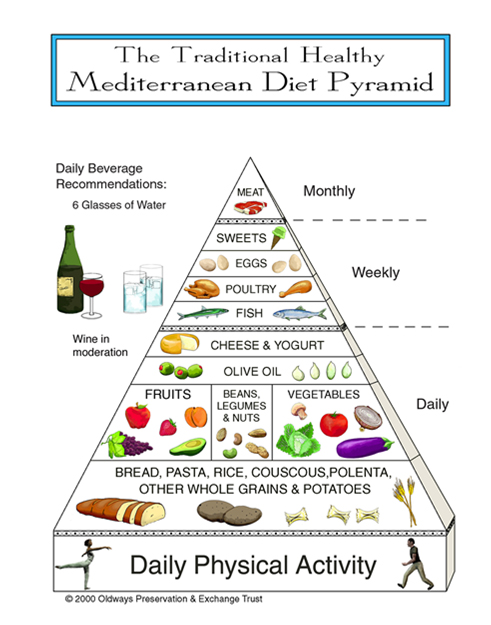Answer: There are numerous countries that border the Mediterranean Sea including the northernmost countries of Africa, some of Southern Europe, Turkey and the Aegean islands. The Mediterranean Diet is not one specific diet, but represents a set of dietary choices that is common in this region of the world.
The basic tenets of the diet compared to a standard American diet are higher consumption of fruits, vegetables, fish, nuts and olive oil, in conjunction with a lower consumption of red meats, saturated and trans fats. Countries with a Mediterranean-type diet experience some of the lowest rates of heart disease, cancer, metabolic syndrome and obesity, most likely because of their food intake. Adopting this diet in other countries or regions appears to lower rates of heart disease, obesity and related illnesses across numerous age groups. The healthfulness of this pattern is corroborated by epidemiological and experimental nutrition research. The average amounts given are in most cases intentionally nonspecific, since variation is known to have been considerable within this pattern.
The dotFIT Me Program provides you with a number of different menus, including a Heart Healthy/Mediterranean-style menu.
Learn more about dotFIT Me here.
Mediterranean Diet Guidelines:
These guidelines are meant to describe the traditional Mediterranean diet and the components of the Mediterranean diet pyramid. The historical pattern includes the following (with several parenthetical notes adding contemporary public health perspective):
- An abundance of food from plant sources, including fruits and vegetables, potatoes, breads and grains, beans, nuts, and seeds;
- Emphasis on a variety of minimally processed and, wherever possible, seasonally fresh and locally grown foods (which often maximizes the health-promoting micronutrient and antioxidant content of these foods);
- Olive oil as the principal fat, replacing other fats and oils (including butter and margarine);
- Total fat ranging from less than 25 percent to over 35 percent of energy, with saturated fat no more than 7 to 8 percent of energy (calories)
- Daily consumption of low to moderate amounts of cheese and yogurt (low-fat and non fat versions may be preferable);
- Weekly consumption of low to moderate amounts of fish and poultry (recent research suggests that fish be somewhat favored over poultry); from zero to four eggs per week (including those used in cooking and baking);
- Fresh fruit as the typical daily dessert; sweets with a significant amount of sugar (often as honey) and saturated fat consumed not more than a few times per week;
- Red meat a few times per month (recent research suggests that if red meat is eaten, its consumption should be limited to a maximum of 12 to 16 ounces {340 to 450 grams} per month; where the flavor is acceptable, lean versions may be preferable);
- Moderate consumption of wine, normally with meals; about one to two glasses per day for men and one glass per day for women (from a contemporary public health perspective, wine should be considered optional and avoided when consumption would put the individual or others at risk.)
